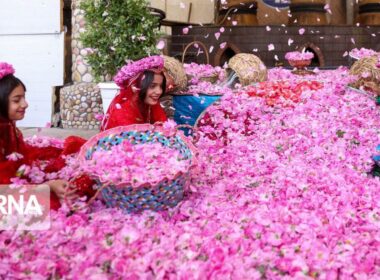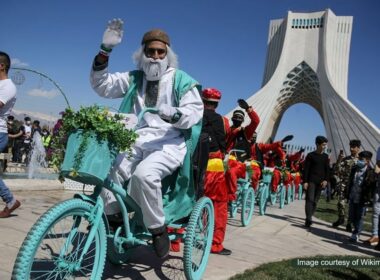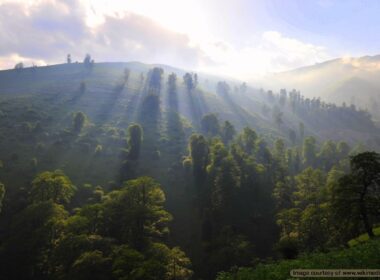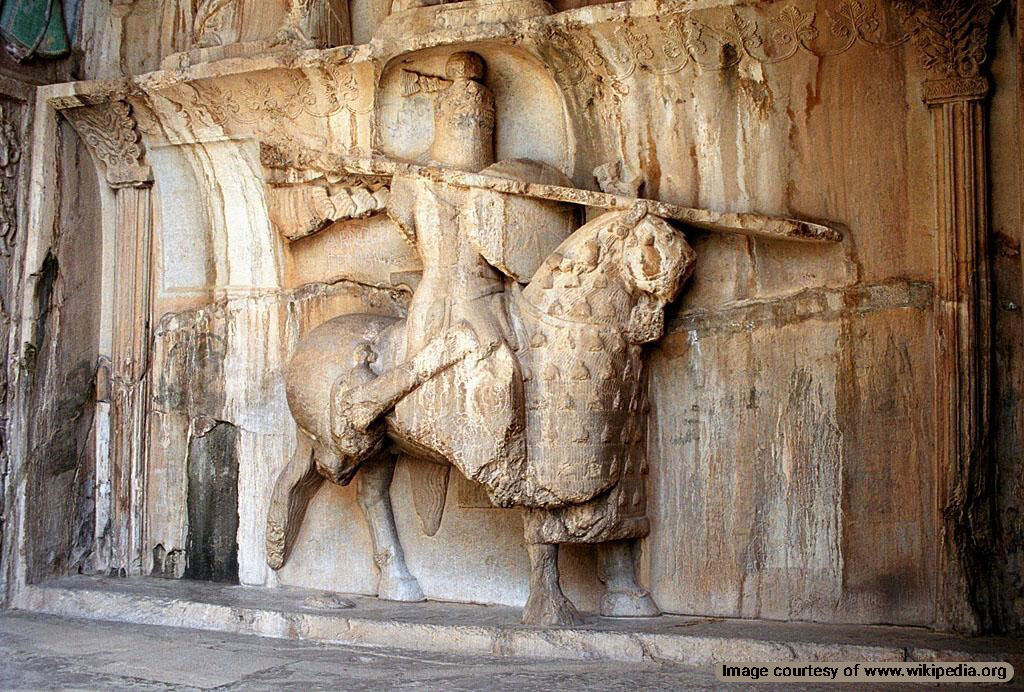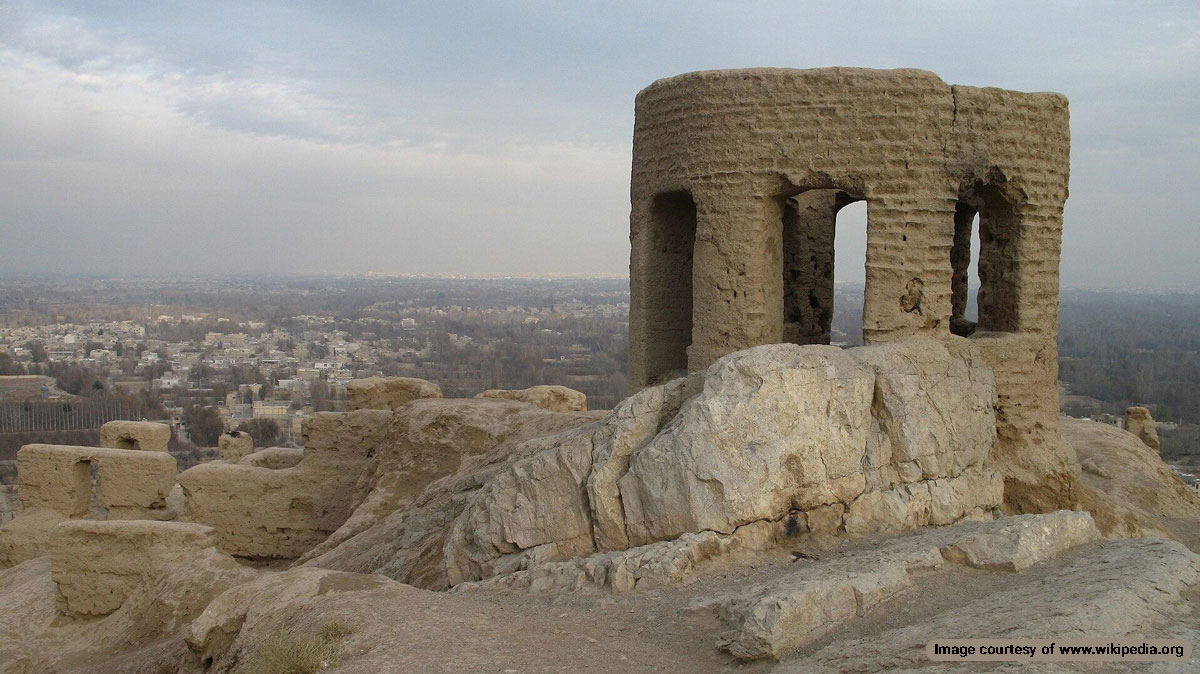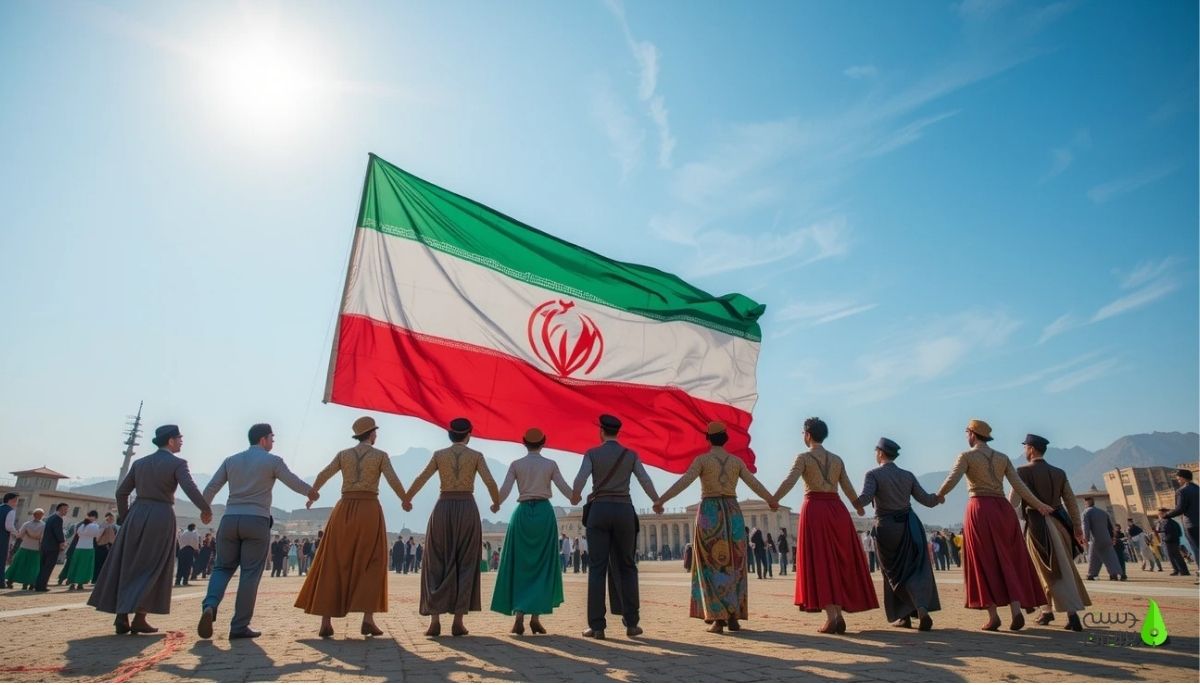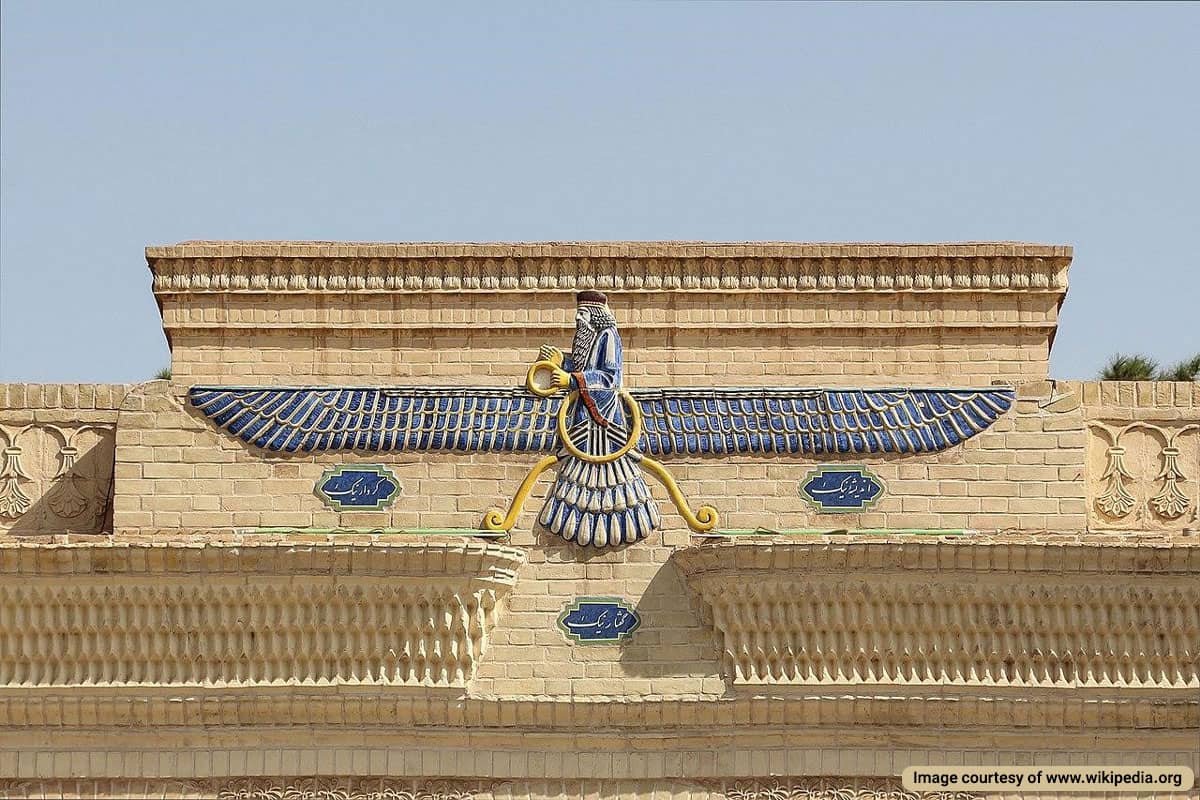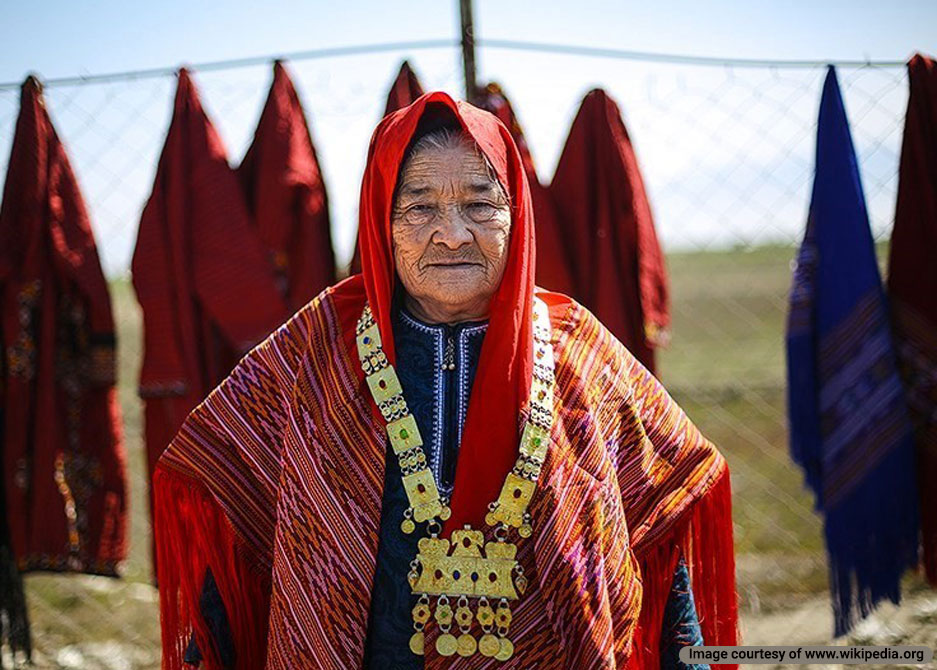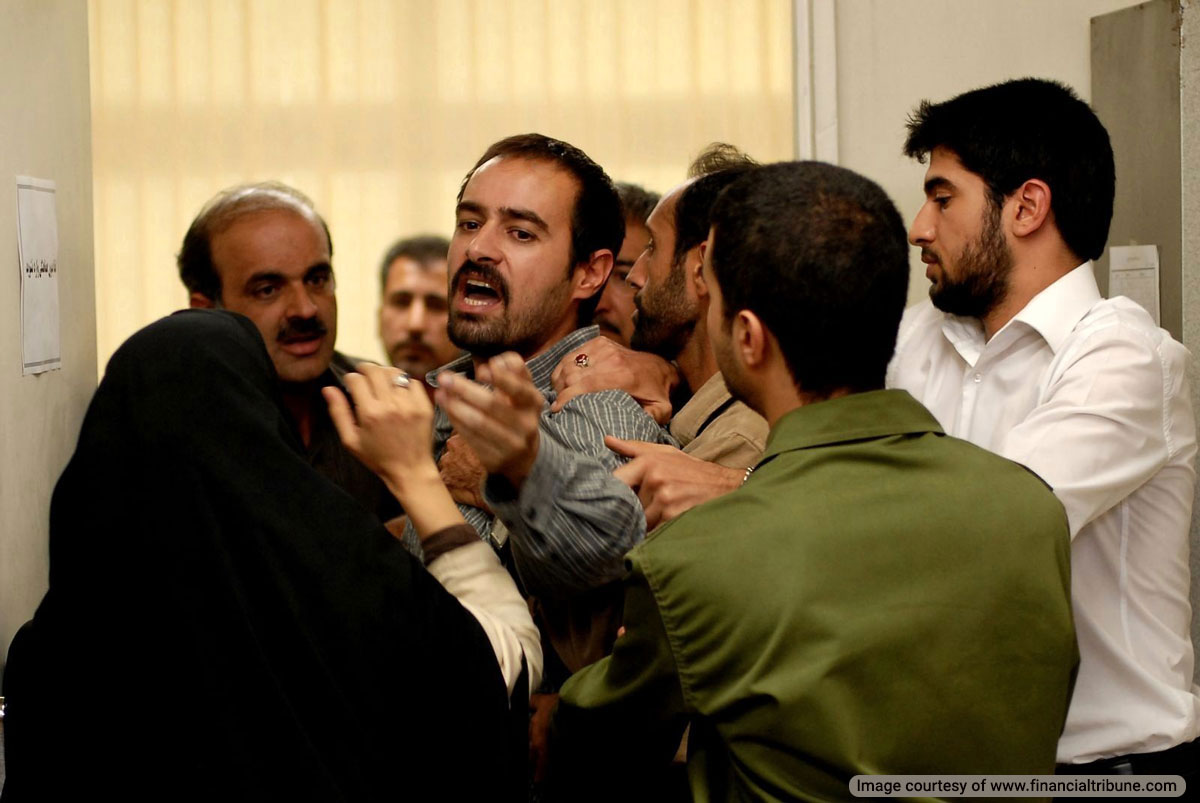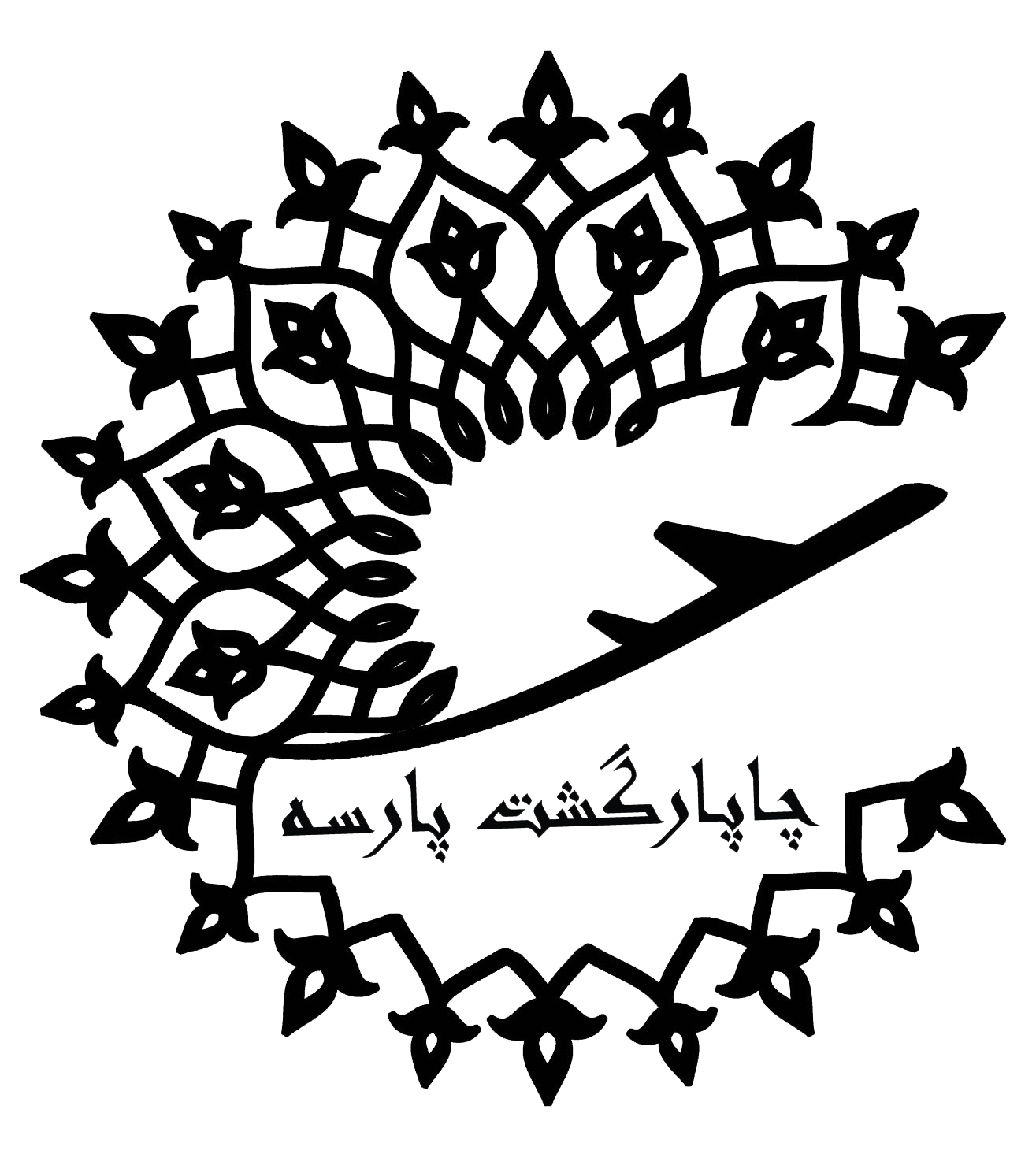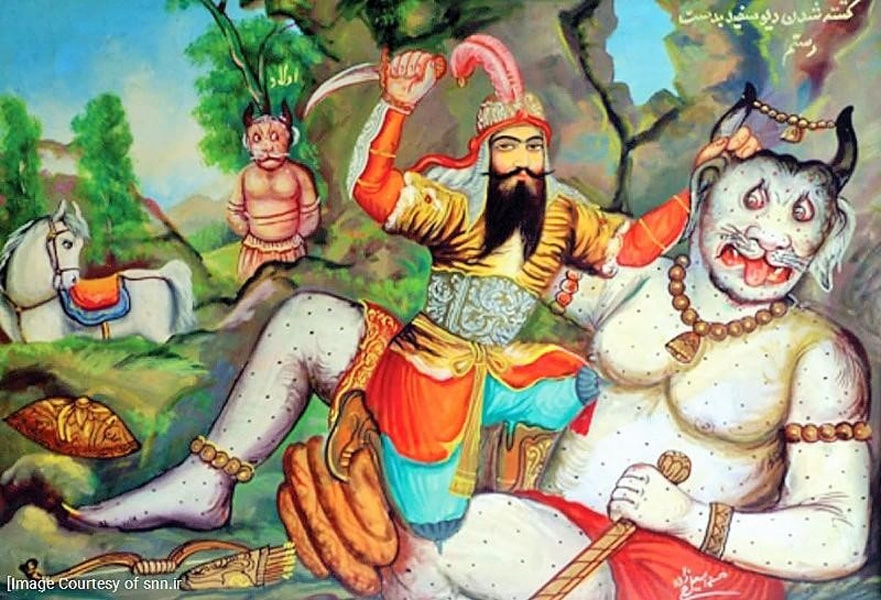
Persian mythology is one of the most important elements of the country’s history and culture. From the distant past to today, traces of Iranian myths can be seen in people’s lifestyles and beliefs.
In the following, we will take a quick look at some Iranian myths, including Iranian urban legends, Iranian folklore stories such as the battle of Rostam and the White Devil (Div-e Sepid), the role of Persian deities like Ahura Mazda, and the significance of Yazatas like Anahita and Mitra.
What Are Iranian Myths & Persian Mythical Creatures?
In Farsi, mythology is called Ostooreh. The root Arabic word is derived from the Greek word “Historia,” which means investigation and knowledge of past events. Iranian myths are often divine or spiritual stories that transcend the real world. Persian mythology includes stories from ancient and primitive periods.
Persian folklore is a reaction to one’s fears of the unknown. People have turned to Iranian folklore stories to answer questions they did Persian mythical creatures not know the answers to.
Persian mythical creatures are usually divided into good and evil groups and have supernatural powers. Divine mythological figures are often portrayed with an aura of virtue.
Ancient Persian gods are sometimes attributed with good characteristics and ideals or known as Iranian mythology gods, such as Mitra, Mithra, or Mehr, the goddess of covenant, oath, and light. Some divine Iranian myths are linked to natural elements, such as Anahita or Aredvi Suita, the goddess of water. Palid (evil) Iranian myths are called Div or Dev, like Akvan Div (Div-e Sepid) or Indra, the king of the Devs and storms and creator of torrential rains.
Key Themes in Persian Mythology
Iranian Folklore stories focus on the main struggle between the good and bad Persian deities. Iranian legends portray the dual ideology present in Zoroastrian mythology, similar to other ancient religions and beliefs.
- The battle between good and evil (Ahura Mazda vs. Ahriman).
- The role of Yazatas (deities) like Anahita, Mitra, and Zorvan.
- Legendary heroes like Rostam and mythical creatures like Simurgh.
The Origins of Iranian Myths
Iranian legends originate from ancient Indo-Iranian and Aryan ethno-cultural markers. In Persian mythology and Indian beliefs, there is a constant war between good and evil. The sacrifice ceremony for the Persian gods is performed similarly, and fire is sacred in both cultures.
Key Sources of Iranian Myths:
- The Avesta (Zoroastrianism mythology): The holy book of Zoroastrianism.
- The Shahnameh: Ferdowsi’s epic poem.
- Pahlavi inscriptions and ancient illustrations from the Achaemenid, Parthian, and Sassanid periods.
Where to Find Iranian Myths
There are several sources for learning about Persian mythology, the most important of which are the “Avesta” and “Shahnameh.” In addition to these two, several other sources help us understand Iranian myths, which we will mention below:
- Old Indian sources and books like “The Vedas.”
- Manichaeism literature, including the writings of Mani and his followers
- Pahlavi inscriptions and tablets (Middle Persian language of the Sasanian Empire)
- Persian and Arabic sources from the first centuries after Islam, the most important of which is “Shahnameh.”
- Ancient illustrations are found in the ruins of buildings from the Achaemenid, Parthian, and Sassanid periods. These include images found on seals, coins, containers, and stone inscriptions.
Yazatas: Persian Deities in Zoroastrian Mythology
In Zoroastrianism, Yazatas are divine beings who represent natural elements and virtues. Here are some of the most important Yazatas:
Ahura Mazda
In Ancient Persian mythology, Ahura Mazda, Oromasdes, is an omnipotent, omniscient, and ultimate divine figure. He is described as the absolute good, perfect in wisdom and knowledge. He is the creator of the cosmos, the sun, stars, light, humans, animals, and all intellectual and physical concepts.
Key Points:
- Ahura Mazda is constantly at war with Ahriman (Persian myths embodiment of evil) and his minions, known as Div Persian mythology characters.
- He represents light, truth, and order in the universe.
- He has created Persian deities to battle the evil of Ahriman throughout creation and empowers them.
- Persian gods in Zoroastrian mythology are all considered aspects of Ahura Mazda.
Zorvan (Zurvan): The God of Persian Infinite Time
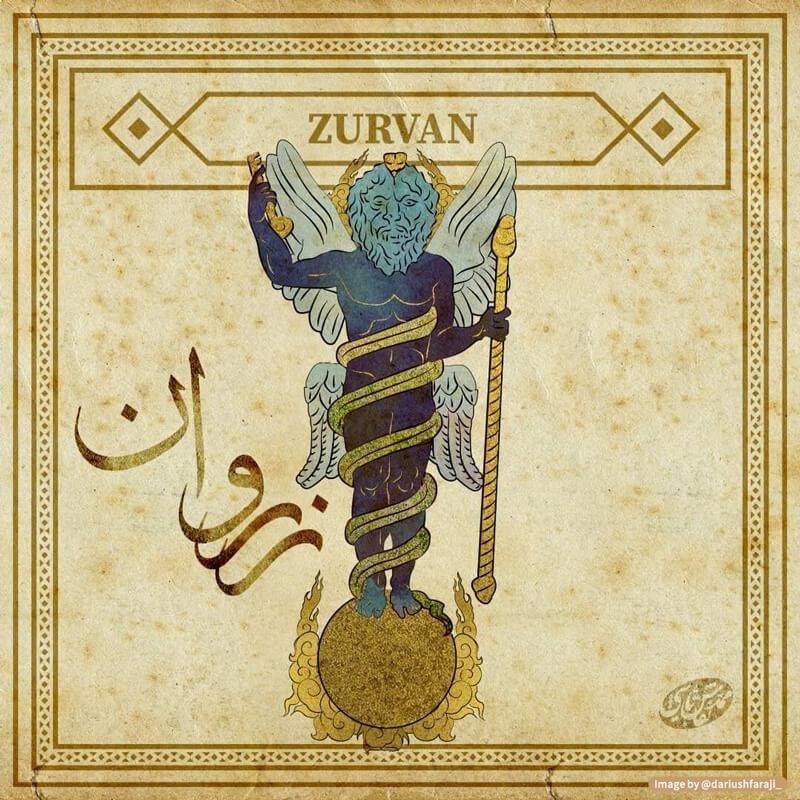
Zorvan, Zurvan, or Zarvan, is one of the Iranian mythology gods. This is one of the Persian mythical creatures associated with time and fate in Zoroastrian beliefs.
Zorvan is often called Zorvan Akarana. He is depicted as a neutral force, overseeing the dualistic struggle between Ahura Mazda (good) and Angra Mainyu (evil). Zorvan’s role as the god of infinite time in Persian Myths represents the eternal flow of time, which encompasses creation and destruction.
Zurvanism Myth of Creation
In Zurvanite mythology, Zurvan is the father of Ahura Mazda and Angra Mainyu. According to the myth, Zorvan desired a child and performed a ritual for a thousand years. Doubt crept into his mind, resulting in the birth of twins: Ahura Mazda, born from his faith, and Angra Mainyu, born from his doubt.
This aspect of Persian mythology highlights the complex nature of Zorvan, who embodies both certainty and doubt. It also reflects the dualistic nature of the universe, where good and evil coexist and influence human destiny.
Cultural Significance
Zurvanism: This sect of Zoroastrianism emerged during the Sassanian Empire and viewed Zorvan as the ultimate source of all things, transcending the dualistic nature of traditional Zoroastrianism.
Zurvanism offered a different perspective on the nature of the universe, emphasizing the role of time and fate in shaping human destiny. Although it eventually declined and remains among the less famous Persian myths, Zurvanism impacted Zoroastrianism and influenced later philosophical and religious developments.
How Does Zorvan Look Like in Persian Legends?
Zorvan is often depicted as a winged, lion-headed figure, symbolizing his dominion over time and fate. This imagery reflects his power, authority, and connection to the celestial and earthly realms. The lion, a symbol of strength and courage, underscores Zorvan’s role as one of the most powerful Persian deities who govern time flow and unfolding events.
Rashnu, the Divine Judge
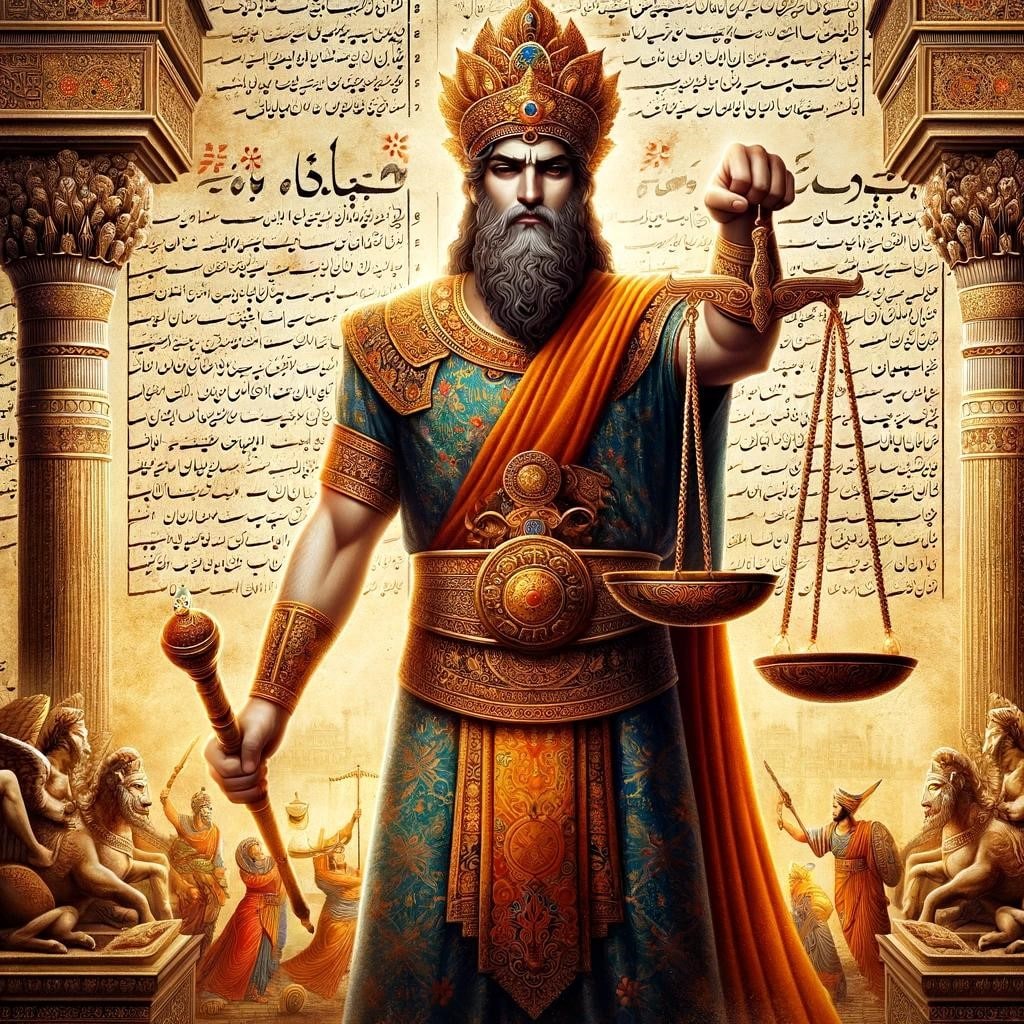
Rašnu, also known as Rašn, is one of the lesser Persian mythology gods, revered as the divine Judge. His name is derived from the verb “raz-” meaning “to move in a straight line” or “to direct,” symbolizing justice and righteousness. Rašnu’s epithet, “razišta,” translates to “the straightest” or “most just,” highlighting his role in upholding justice.
Rashnu’s Role in Zoroastrianism Afterlife
In Zoroastrianism, Rašnu plays a central role in the judgment of souls. Rashnu is closely associated with Mithra, the god of covenants and treaties, and Sraosha, the female Zoroastrian deity of justice and righteousness. Their triad is the tribunal of the dead, who judge the soul at the Chinvat Bridge.
On the fourth day after death, Sraosha leads the dead to the Chinvat Bridge, where Rašnu weighs their deeds on his scale. His scales are perfectly balanced, ensuring impartial judgment. This process determines whether a soul can cross the bridge safely or fall into the abyss.
The Chinvat Bridge, also known as the Bridge of the Separator, is a symbolic structure that separates the world of the living from the afterlife. The judgment process is meticulous, with Rašnu considering every action and intention of the soul. This ensures that justice is served, and only the righteous can enter the realm of the blessed.
Rasnu in Persepolis Fortification Tablets
Rašnu’s invocation in legal and judicial contexts underscores the importance of truth and justice in ancient Iranian society. His mention in the Persepolis Fortification tablets, a collection of administrative records from the Achaemenid Empire, indicates that his worship was widespread and significant even outside strictly Zoroastrian contexts.
These tablets reveal that Rašnu was invoked in legal matters, ensuring that justice waved in civil and criminal cases. This highlights the deep-rooted belief in divine justice and the importance of maintaining social order through truth and righteousness.
Rituals and Worship
Rašnu is invoked in fire and water rituals, elements that symbolize truth and purity. Fire, considered a sacred element in Zoroastrianism, represents the divine light of Ahura Mazda, the supreme god. Water, another sacred element, symbolizes purity and life. These rituals were designed to invoke Rašnu’s presence and ensure the integrity of judicial proceedings. Devotees recite specific prayers and hymns to Rašnu, seeking his guidance and blessing in matters of justice and truth. These occur in fire temples, where priests perform ceremonies to honor Rašnu and other deities.
Anahita, the Persian Deity of Water
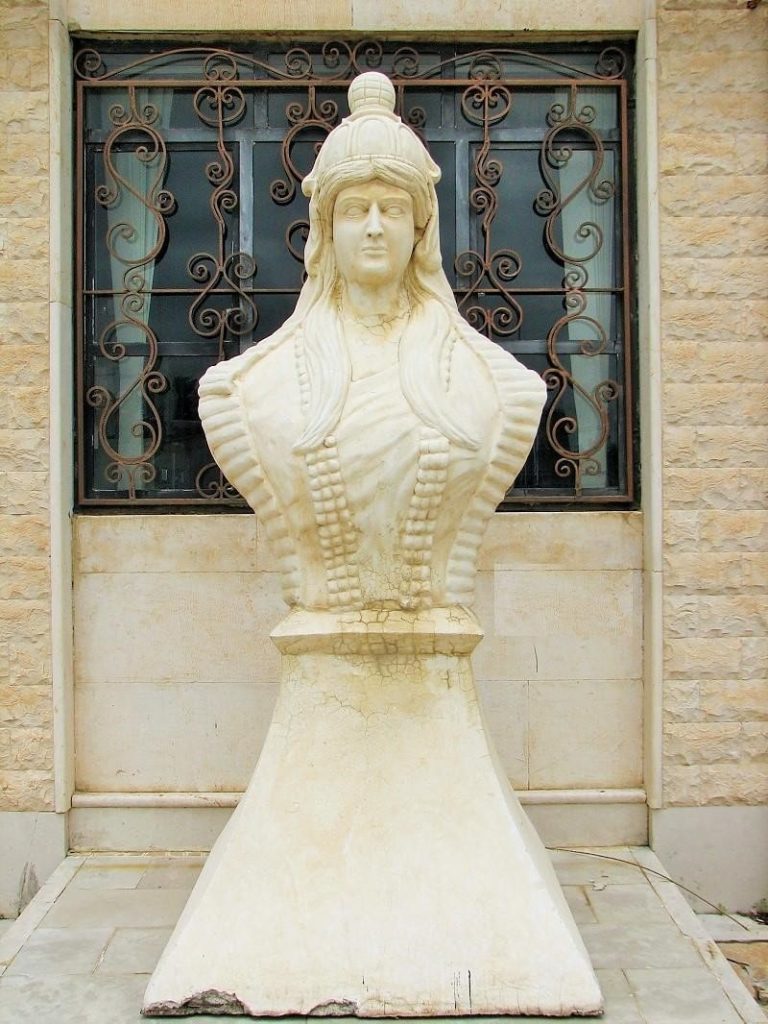
Anahita, Anahit, Venus, or in ancient Pahlavi, “Ardvisura Anahita,” is the goddess of waters in Iranian mythology. She was worshiped in the Iranian plateau before the arrival of the Aryans and is older than Zoroastrian mythology figures. Anahita and Sepandārmazgān are two important goddesses in Iranian mythology. Anahita shares features with Aphrodite, the goddess of love and fertility in Greek mythology.
Water has been sacred among Iranians since the distant past and was considered the source of life and the birth of nature.
Herodotus has written about the importance of water among Iranians:
“Iranians do not urinate in the river; they do not spit in water. They don’t wash their hands with water or allow others to pollute it with anything. They have a lot of respect for water.”
Anahita means “pure and uncontaminated,” like water. This feature was attributed to Aredvi Sura Anahita, the original name for the goddess of water in the inscription of Artaxerxes II and numerous tablets from the Achaemenid period. Later inscriptions omitted the “Aredvi Sura” prefix, and the goddess is called Anahita. She is known by the same name in the Avesta.
During the reign of Ardeshir II or Artaxerxes II, Anahita became so important that a fire temple was built in her name. In later descriptions, she is called the custodian of all the water on earth. Anahita protects properties, homes, the nation, life itself, the cosmos, and the kingdom of Persia. In the sixth verse of “Aban Yasht,” or hymn to the waters, Ahura Mazda states that he created Nahit or Venus to develop, maintain, and guard the kingdom and nation. This goddess is depicted in the relief of Naqsh-e Rostam, one of the tourist destinations of Fars province.
Anahita Temple
Since the Achaemenid period, many temples in Iran have been built in Anahita’s name, such as the Anahita Temple in Kermanshah’s Kangavar and others in Bishapur, West Azerbaijan, Ecbatana Temple, and Takht-e Soleyman.
Ordinary people also set up small shrines with wooden roofs and pillars next to the fields to worship this goddess, and they prayed to Anahita for the abundance of crops and rainfall.
Mithra, Persian Deity Light and Loyalty
One of the ancient Persian deities was Mehr or Mithra, who was worshiped before Zoroaster and is highly praised in the Avesta. In Persian mythology, Mehr or Mithras is the Iranian god of loyalty, pact, and war. He is known as the protector of the family, the Capital, and the kingdom as the Light bringer.
In the Avesta, the Mitra deity is described as “the Iranian god of light.” In Greek mythology, Mithras is often compared to the god of light.
In Iranian myths, Mehr is said to have no parents and to have emerged from a mountain. Alborz is considered his birthplace.
In the Avesta and the tablets of the Achaemenid kings, Mehr (another name for Mithras) is called Mithra. It appears in Sanskrit writings and is one of the more ancient Persian deities known as Mitre. However, in the existing Pahlavi language records, the sun god is addressed as Mitr. Today, Mithra is known as Mehr, which means sun.
A small arch in Kermanshah’s Taq-e Bostan contains a stone relief from the Achaemenid period. This inscription depicts the Mitra deity next to Ahura Mazda and Artaxerxes II.
Features of Mitra
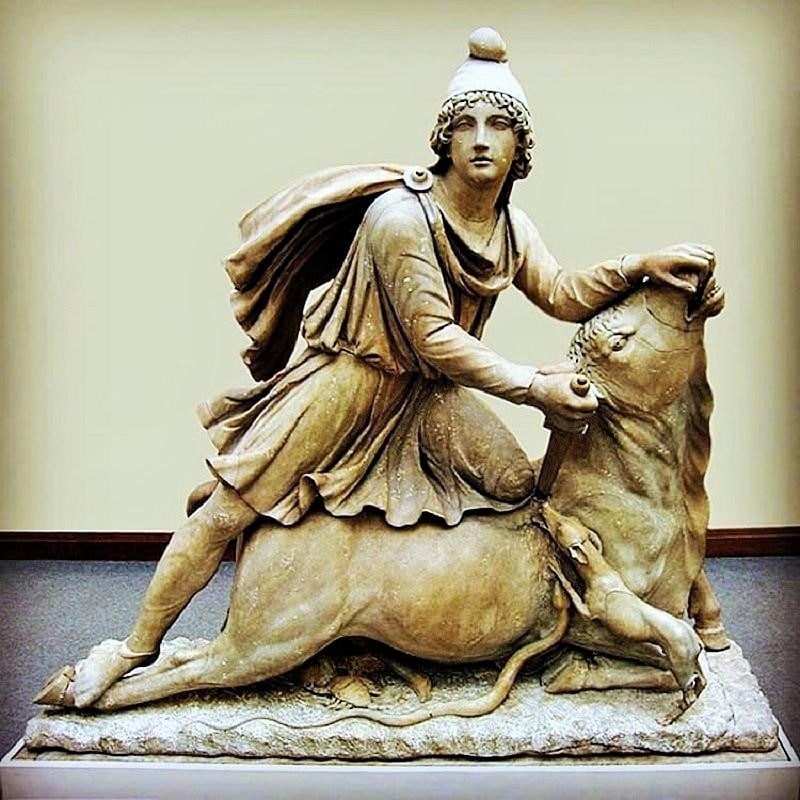
A figure of this Persian god is in all the Mehr temples: a young, strong man intending to sacrifice it. A dagger is in the hand of the mighty Mithra, who is about to plunge it into the bull’s heart.
As described, Mithraism became popular in Europe during the Parthian Empire. Many temples were built to worship Mithra, and the religion found many followers.
The Birth of Mehr
Mithra was born on Yalda night. A night that has had a special place among Iranians for a long time. On this longest night of the year, Iranians stay awake and celebrate, waiting for the victory of light over darkness and the sun’s birth sun.
After this night, the sun triumphs over darkness, and the days get longer.
Return of Mithra
In Iranian mythology, it is said that on the last day of his life, Mithra held a party in a cave, where he and his companions ate a cow’s blood and beef with bread and wine and then rode the sun’s chariot to the sky. According to Mithraism, Mithra ascended to the sky. Therawait awaits his return to earth to reform humanity and destroy evils and impurities. According to the Mithraist’s beliefs, the Mitra deity will return one day and light the fire that will consume the cosmos, as Shiva, the Pan-Hindu deity, is prophesied to do. Mithra cleanses the world of evil and destroys darkness and the Dev.
Bahram, The Warrior of Persian Deities
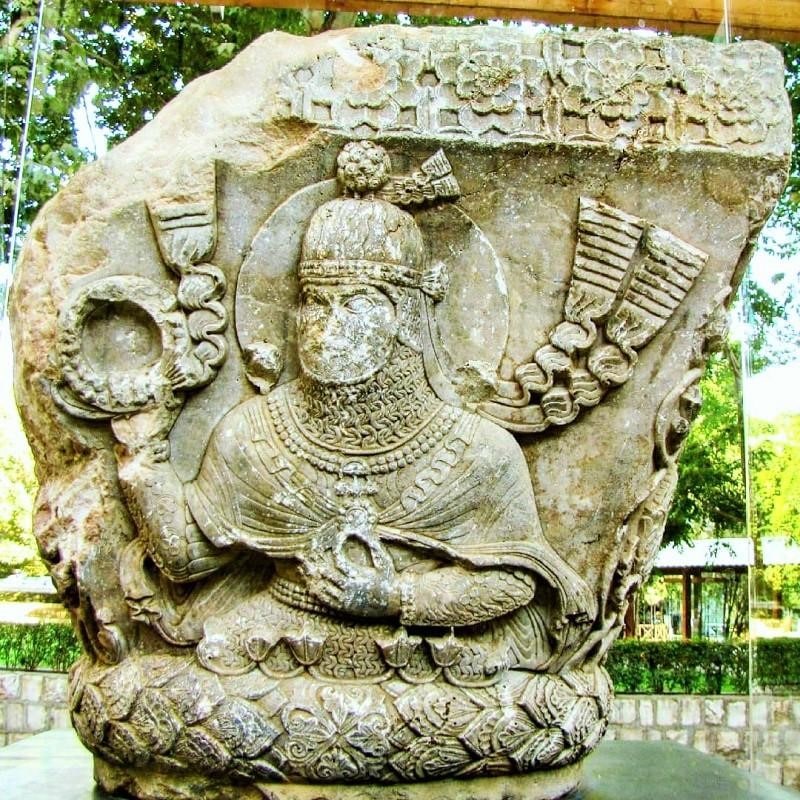
Bahram is the name of one of the main Persian deities of Mazdaism, which is believed to be very powerful. This god is called Verethragna in Avesta, “Varahran” in Pahlavi texts, “Varaam” in Armenian, and “Gooram” in Georgia.
According to the Avesta narrative, Izad Bahram first appeared to Zoroaster as wind.
According to Zoroastrian mythology, Izads are from the Minavi (spiritual) world and manifest in different forms in the material world. Verethragna appeared in ten different human and animal forms:
- fast wind
- beautiful bull with golden horns;
- beautiful white horse with yellow ears and golden bridle;
- agile and wild camel that bites;
- charging male boar with sharp tusks;
- A fifteen-year-old bright man with bright and beautiful eyes and small heels;
- “Vaughan” bird, which strikes from below and dives at its prey from above, and is the fastest among avian;
- A beautiful prairie ram with curved horns;
- A beautiful male desert goat with sharp horns;
- A magnificent man who has a gilded knife with engravings and enchantments.
Verethragna or Bahram
Vartha Ghana, or Bahram, is the god of warriors and conquerors and the granter of victory over the Div. Ahura Mazda has advised Zoroaster to take the feather from Verethragna in his bird form whenever he is affected by evil magic.
Warriors in Bahram Yasht or Warharan Yasht ask Izad Bahram to grant them strong arms, healthy bodies, and sharp eyes. Bahram is the most powerful and resourceful of Iranian mythology gods. He is the god of war and victory and the reviver of the world.
His power made him popular among soldiers, who praised him and asked for his help in battles. Soldiers from other countries adopted this custom. Izad Bahram is powerful, grants courage, and has attributes similar to Izad Mehr, the custodian of home and kingdom.
In Bahram Yasht, it is said that Bahram’s special mantra (prayer or word) is so powerful that Ahura Mazda warns Zoroaster to teach it only to his close allies and Aturbans (guardians of fire) and not anyone else.
Another feature that makes Izad Bahram similar to Izad Mehr is his association with sight and vision. He is a clairvoyant and the possessor of “Sookeh,” which is the brightness and sharpness of the eyes. Sookeh has remained as “Soo-ye Cheshm,” which means vision.
Vayu-Vata or Vayu, The Iranian god of Wind
Izad Vayu, or Vay, is the god of wind and one of the oldest Persian gods. In “Avesta” he is referred to as Izad Vay.
Vayu reigns between heaven and earth and between the realms of Mazda and Ahriman and has a dual nature of good and evil. Sometimes, it is destructive; sometimes, it is constructive and not an entirely good or evil figure. He is the source of the gentle and calm breeze spreading tenderness and fertility and delivering destructive and terrifying storms. He does not belong to the sky nor the earth and freely rules the dominion between the two.
In the Pahlavi texts, he is described as “Dirandeh Khodai” or “Derang Khodai,” which means god of long-lasting rule.
It is written in Ram Yasht: “O Asha Zoroaster, truly my name is Ander Vayu. Therefore, I am indeed both the creation of Spenta Mainyu and Angra Mainyo”.
Tishtrya, Persian Deity of Rain
The people living on the Iranian plateau have always struggled with drought. Rain, a blessing sent by the Persian gods, quenched people’s thirst and irrigated the fields. This heavenly gift had its god: Tishtar or Tishtrya.
Tishtar is the Pahlavi name of this Izad, and in Zoroastrian sources, he is called Tishtra, Tashtar, or Tir.
Every year after the victory over Apaosha, the demon of drought, Tishtrya would unlock the rain reserves in the vast Cosmic Ocean.
Tishtar is one of the Persian deities of absolute goodness and grace with no demonic traits. He shares the water between the lands and is also the god of birth and fertility.
Tirgan festival is a ritual for Iranians to praise the god Tir.
The Mythical Battle of Tishtar and Apaosha
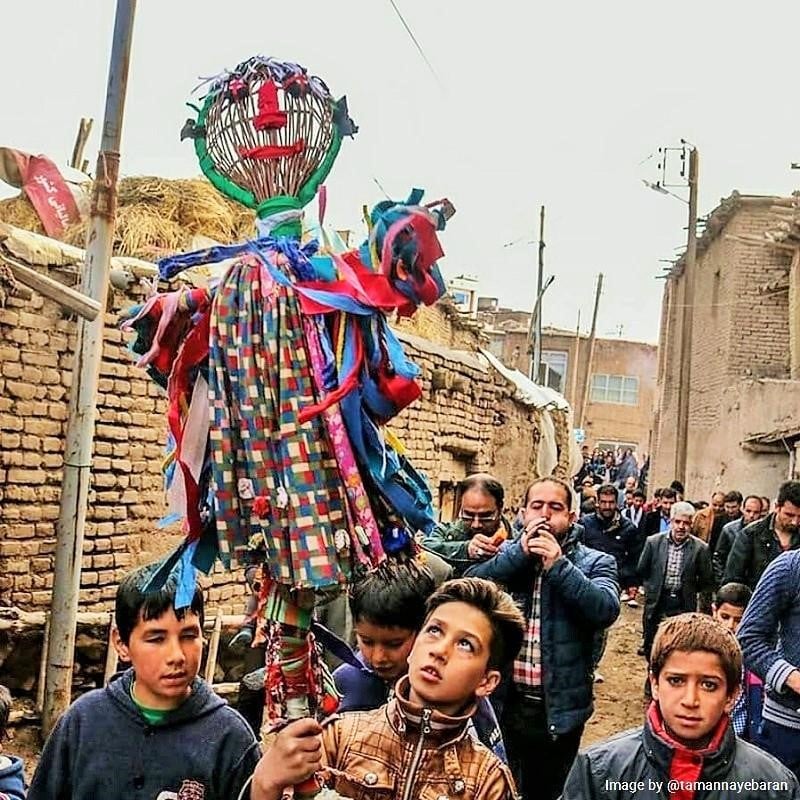
In Iranian mythology, it is said that Tishtar goes to the sea in the form of a beautiful white horse with golden saddles and battles with Apush or Apaosha, who manifests as a black horse, for three days and nights. Apush, who is stronger, overcomes Tishtar.
Tishtar complains to Ahura Mazda that my weakness is because the people did not pray and sacrifice in my name. So Ahura Mazda makes sacrifices in the name of Tishtar, and the strength of ten horses, ten cows, ten mountains, and ten rivers is bestowed upon Tishtar. With increased strength, Tishtar goes to battle again with the drought demon and wins. With the victory of Tishtar, water will flow in the fields and pastures, and vitalizing rain will fall on the seven lands of the earth.
Tir, The Month of Izad Tishtar
July, the fourth month of the Persian calendar, is named after this benevolent deity. Tishtar has three material manifestations. During the first ten days of Tir month, he appears as a fifteen-year-old. In the second ten days, he appears as a bull, and in the third ten days, in the shape of a horse.
The thirteenth day of every month is called Tir in honor of this god. Whenever drought made life difficult for ancient Iranians, they would perform a special prayer ritual for Tir on this day. They would go to the plains, pray for the victory of Tishtar over the demon Apush, and recite Tir Yasht from the Avesta.
Azar, Deity of Fire
Fire is sacred in the beliefs of ancient Iranians and the Zoroastrian religion. Azar, or Atar, is the god of fire. He is a male Izad and the son of Ahura Mazda.
In the Avesta, this god is mentioned as Atar or Atrash. In Pahlavi texts, he is called Atoor, Atar, and Atash, and in Persian, Azar, Ader, Avar, and Atash. The root of all these words is the Sanskrit word Agni, which means fire.
The person guarding the fire was called “Aturban.”.
Immediate divine intervention, instant assistance, an easy life, wisdom, purity, eloquent language, wisdom, awareness of the mind, lasting integrity, courage, and masculinity, as well as an abundance of offspring and the safety of the kingdom, are the virtues that Azar grants to his worshipers.
The god of fire comes to the aid of the god Tishtar in his victory over the Div of drought, Apush. Also, he helped Jamshid of the Pishdadian dynasty defeat the Div Azhi Dahāka.
Azargan festival is a ritual in worship of the god of fire. The sunflower is one of the symbols of this ancient Iranian mythological figure.
Fire, a Sacred Element in Zoroastrian Religion
Fire is sacred among Zoroastrians. They pray to Ahura Mazda next to the radiant flames of the fire.
In Iranian myths, fire is an element that cannot be corrupted; It purifies the other three main elements of the world: water, earth, and air.
In Zoroastrian belief, fire symbolizes light and purity and is made from wisdom and thought. Every human being should keep the fire of his essence burning with vigilance and righteousness and unite it with the light of Ahura Mazda.
Izad Azar and Waking Up Early
In Iranian mythology, it is said that when two-thirds of the night has passed, the god of fire gets worried about the extinguishment of fire on earth. So, he asks Izad Soroush or Sraosha to awaken the roosters so they can start crowing. The roosters sing, “O humans, wake up and pray, curse to the demons. Otherwise, the long reach of the demon Joshab will prevail over you.”
Izad Hom
Hom or Haoma is one of the Iranian myths and the son of Ahura Mazda. The word “Hom” has two meanings in the Avesta: the name of a sacred plant and the god who guards over this plant.
Izad Hom visits people and gives them Hom nectar, which grants them happiness and prosperity and blesses them with noble sons.
Also, Izad Hom invigorates and blesses pregnant women with celebrated sons and is the source of purity and prudence. It heals and wards off death and is linked to good deeds, words, and thoughts.
The Hom plant is the natural manifestation of the god Hom and is sacrificed by being squeezed. In a sense, people squeeze Hom, sacrificing a weaker divinity in the name of a stronger form of the deity. Hom juice is used to prepare a psychedelic drink, which is consumed during prayer rituals. It was believed that it caused physical and mental resilience.
Divs and Forces of Evil in Iranian Mythology
Ancient texts do not discuss the creation and characteristics of Ahriman forces and Divs as much as they do the creation of Persian gods and divine entities. Existing texts do not clearly depict their characteristics; sometimes, they are limited to a name.
Just as evil is always confronted by good, Ahriman is the opposite of Ahura Mazda and Izadan (Persian gods). Every Izad has an Ahriman counterpart with whom they are constantly at war. There is also a Div for every bad personality trait.
Like Izadan, Divs also have different ranks. Six Div are the highest in rank among the Divs, and they are called Sar-Divs (top demons) or Kamale-gan. After them, there are the Div, who are either at war with Izads or manifest a bad trait in humans and the world. In the following, we mention some demons:
- Joshasb: The demon of sloth and laziness
- Aeshma: The demon of anger
- Az: The demon of greed
- Sepazg: The demon of tale-bearing and backbiting
- Varan: The demon of lust
- Bot: The demon of false Persian gods and idols
- Perimati: The demon of arrogance
- Reshk: The demon of jealousy
Ancient Iranian Myths About Creation
Ancient Iranians believed that everything was created in a particular order. Ahura Mazda created the marvels of the universe in one year and six stages: sky, water, earth, plant, beast, and man.
Some also consider fire as the seventh marvel.
- Sky: Ahura Mazda created a vast, bright sky. Ancient Iranians considered the sky made of stone, later metal. The sky was a shield against Ahriman’s attacks.
- Water: Water was created as a drop as large as all water.
- Land: The land was initially created as a flat sphere without relief. The first mountain that emerged from the earth was Alborz.
- Plant: The first plant was a single twig that included all the plants that grew at the foot of Alborz Mountain.
- Beast: The cow was the first beast that was created. It was white and bright like the moon, and Ahura Mazda created it in harmony with water and plants.
- Man: The first man was called Keyumars or Gayomart. A rhubarb plant grew from the seed of Keyumars after 40 years with two stems. The stems were so intertwined that it was impossible to tell which was male or female. They were the first human mates on Earth.
Iranian Mythical Figures and Persian Deities
Whenever Iranian mythological characters and creatures such as Simurgh, Ghoghnos (Phoenix), Rostam, and Sohrab are mentioned, we all remember Ferdowsi and his unique epic “Shahnameh.”
In his epic poem Shahnameh, Ferdowsi has described Iranian mythology with such eloquent language that it will always be immortalized in the hearts and souls of Iranians, and this chapter of ancient Iranian culture will be spared from the malice of oblivion.
In the following, we introduce some of these creatures and characters from Iranian urban legends.
Simurgh
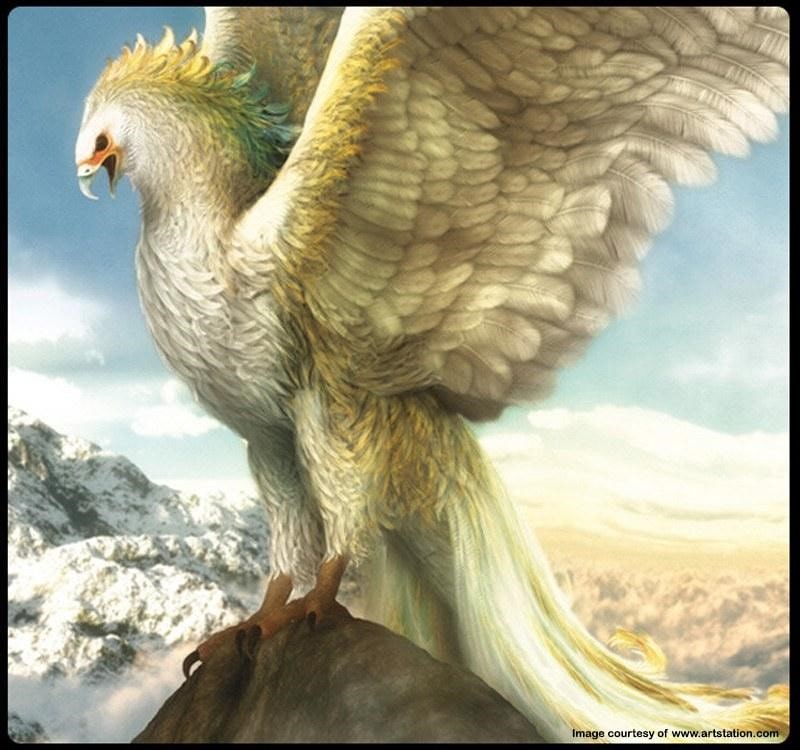
The Simurgh or Simorgh is one of the most famous Persian mythical creatures. It resembles the falcon, the Griffon, the Huma Persian mythology bird, and other legendary birds.
Simurgh is one of the most important creatures in Persian literature. Ferdowsi focuses a lot on this bird in the Shahnameh. He has a nest in Qaf Mountain and is knowledgeable and wise.
He nurtured Zāl and assisted Rostam in defeating Esfandiyar. Simurgh also plays a significant role in “The Conference of the Birds,” a famous collection of poems by Attar of Nishapur.
The Simurgh sits on the Gaokerena tree, which contains the seeds of all plants on Earth. By flapping its wings, the Simurgh spreads these seeds worldwide.
Huma Persian Mythology Bird
The Huma, also known as the “bird of paradise,” is one of the Persian mythical creatures in Iranian folklore that is revered as a symbol of divine blessing, eternal fortune, and kingship. Unlike other mythical birds, the Huma is said to never land on Earth, eternally soaring between heaven and the mortal realm. Its shadow or touch is believed to bestow sovereignty upon those it favors, making it a sacred emblem of royal legitimacy.
The Huma, a Persian mythological figure, is often depicted as a majestic bird with golden-green plumage, combining the features of an eagle and phoenix. It never alights on the ground; its eternal flight symbolizes transcendence and spiritual elevation.
In Persian folklore, if the Huma’s shadow falls on a person, they are destined to become a king or leader. This myth underscores the bird’s role as a divine arbiter of power. The Safavid dynasty reportedly used the Huma as a royal symbol to legitimize their rule.
Featured in works like Attar’s The Conference of the Birds as a metaphor for spiritual aspiration in Iranian legends. The Persian saying “Huma-ye sa’ādat” refers to an unexpected stroke of good fortune.
Kar Mahi
Fish are especially significant in Iranian myths. Since they live in water, ancient belief holds that they are the servants of the custodian Persian deities of water. In Iranian mythology, Jamshid was the first person to breed fish.
Kar fish is the guardian of the sacred Hom tree, Gaokerena. Ahriman sends a lizard to chew the Tree of Life’s roots and destroy them. But two Kar Mahi guard the tree’s roots in the primordial waters and protect them from the bites of Ahriman Persian mythical creatures such as toads.
The Owl
In Iranian mythology, the owl is mentioned by the names Ašō Zušta and Morgh-e Bahman. Owl is also called Boom, Boof, and Kuch in Persian.
The owl has a dual existence in Iranian mythology. According to Iranian myths, the owl was created to face Ahriman forces. He is knowledgeable and knows divine enchantments. Divs are frightened by his divine enchantments and escape. In the ninth section of the Pahlavi book “Bundahishn,” this bird is called “Mazda Afraid,” its name appears next to the rooster and Karsheft, other Zoroastrian holy birds.
Karshaptar or Karsheft
Krushpeter is a fast-flying bird and one of the famous Persian mythical creatures, spreading the teachings of the Prophet Zoroaster worldwide. He is a bird that knows human languages and is similar to Simurgh.
Chamroosh
Chamroosh is the name of a bird in Iranian mythology that lives on Alborz Peak. It is very big, with a body of part wolf and part dog, an eagle-like head, and wings. The bird flies in the sky, hunts the enemies of Persia, and helps scatter the seeds of the Gaokerena tree.
Evil Creatures in Iranian Myths
Just as Ahura Mazda and the Persian gods were at war with Ahriman and Divs, evil creatures went to war with heroes and good-hearted people. A creature like Azhi Dahāka, which is called Zahhak in the Shahnameh. Zahhak was a man who had two snakes growing on his shoulders. He heeded the Ahriman’s command and started shedding the blood of innocent people. Here are some other examples of Div Persian mythology creatures:
Khrafstra (Xrafstar): Angra Mainyu’s Evil Animals
Khrafstra is a general term for evil Persian mythical creatures in Zoroastrian mythology. These beings are considered creations of Angra Mainyu, who formed them from darkness to oppose Ahura Mazda’s creations. The category includes harmful or repulsive animals that crawl, creep, or bite, such as snakes, frogs, scorpions, and pests like ants and locusts.
Gurgan (wolves) are also associated with evil spirits and demonic entities. The Evil Spirit created them in the secret form of 15 species. In this instance, Gurgan is a cover term for animals other than wolves, such as tigers, lions, panthers, cheetahs, jackals, hyenas, sharks (marine wolves), and other species, not necessarily mammals.
Cultural Significance
Zoroastrians perform specific rituals to combat Khrafstra, including recitations from the Avesta and using sacred elements like fire and water. These rituals purify spaces and protect against the corrupting influence of demonic entities. The recitations, known as Yasnas, invoke the power of Ahura Mazda and other Persian deities to drive away evil forces.
The use of fire and water in these rituals symbolizes the purification of the physical and spiritual realms, ensuring that the forces of good prevail over chaos and corruption. However, these animals are not always harmful or useless. These evil animals can benefit humans through the Ahura Mazda’s grace. If mixed with one of the sacred elements—fire, earth, wind, or water—they can be used to prepare remedies.
Symbolism
Khrafstra represents the world’s physical and spiritual corruption. Zoroastrian texts often mention them as targets for ritual purification and destruction. These demonic creatures remind us of the constant struggle between good and evil and the need for vigilance and righteousness in maintaining cosmic order. By combating Khrafstra, Zoroastrians reaffirm their commitment to truth, purity, and the divine order established by Ahura Mazda.
Manticore: The Man-Eater
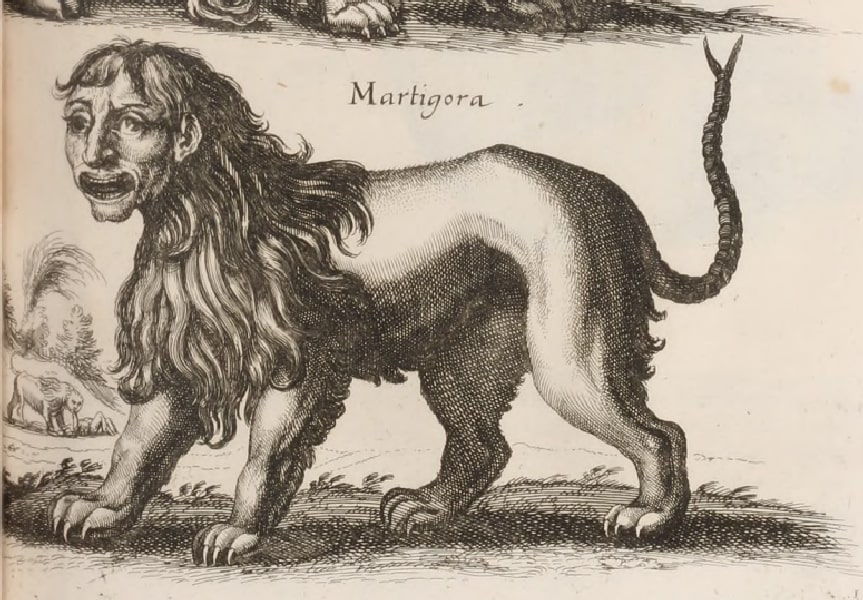
The Manticore is a legendary creature from ancient Persian mythology, known for its fearsome appearance and deadly nature. The Manticore has the body of a lion, the head of a human, and the tail of a scorpion or a tail covered in venomous spines. It is said to have three rows of sharp teeth and can shoot its spines like arrows.
Origins and Name
The word “Manticore” comes from the Old Persian term martyaxwar, meaning “man-eater.” This reflects its reputation for preying on humans. Greek writers popularized the Manticore’s Iranian urban legends, having heard tales of this creature from Persian sources. The Manticore symbolizes the dangers lurking in the wild and the unknown. Its fearsome reputation made it a symbol of the untamed wilderness, where danger and death awaited those who ventured too far from the safety of civilization.
Cultural Depictions
The Manticore appears in various works of art and literature, both in Persian culture and later in medieval European bestiaries, where it was depicted as a symbol of treachery and danger. Its fearsome image has persisted through the ages, representing the unknown perils that lie beyond the safety of civilization.
Based on the descriptions in Iranian folklore, the Manticore is often depicted in paintings in hunting scenes, symbolizing the bravery and skill required to confront such a formidable foe. In European bestiaries, Manticore’s image illustrates moral lessons about deceit’s dangers and vigilance’s importance.
Symbolism and Legacy
In Iranian legends, the Manticore symbolizes the unknown and the dangerous. It reminds us of the perils beyond the familiar and the need for courage and wisdom in facing the world’s challenges. The Manticore’s legend continues to captivate the imagination, inspiring stories, artworks, and even modern interpretations in literature and popular culture. Its fearsome image and the moral lessons it embodies ensure that the Manticore remains a powerful symbol of the dangers that lurk in the unknown.
Modern Interpretations
In contemporary culture, the Manticore has appeared in various forms of media, including books, movies, and video games. It often appears as a formidable adversary, challenging heroes with its deadly abilities and cunning intelligence. The Manticore’s presence in modern storytelling highlights its lasting impact on the collective imagination. It symbolizes the ultimate predator and the embodiment of nature’s untamed ferocity.
Div-e Sepid
In Iranian myths, Div-e Sepid, or the White Demon, is a servant of the Ahriman Persian mythology, the chieftain of Divs, and lived in Mazandaran. The white demon imprisoned Kay Kāvus, the king of Greater Iran, and his army in a cave. After a hard fight, Rostam killed the white demon and released the king.
Akvan The Div
Akvan was a Div Persian mythology who appeared as a zebra, attacked the herd of Kay Khosrow’s horses, and killed them. Kay Khosrow called Rostam for help. After a tough battle, Rostam defeated Akvan the Div.
Dragon
The dragon is a legendary creature in Iranian folklore and a Legend in Persian, mentioned in mythical narratives from different nations. It is usually a giant reptile that can sometimes fly or breathe fire. In Iranian mythology, the dragon is the ultimate evil and Ahriman-Zad (evil-born).
As one of the Shahnameh characters, Rostam fights and defeats the dragon in his third Khan(quest). There is this interpretation of Rostam’s fight with the dragon: the dragon was Rostam’s ego that he faced from the start. Rostam, who did not recognize the dragon properly, could not defeat it. But after getting to know himself, he was able to triumph over it.
The First Humans and Great Warriors in Iranian Myths
Keyumars
Keyumars, which means Mira or mortal, is the first man in Persian myths. He is described as tall, attractive, and bright as the sun.
He was believed to have been born from the earth and was the first human created by Ahura Mazda. He was alone in the mountains for thirty years. After his death, the sun’s rays purified his seed. From that pure seed, a plant grew that formed the first human couple from its two intertwined stems.
The story of man’s creation in Iranian mythology has many fascinating details.
Hushang
In Iranian mythology, Hushang is one of the first kings mentioned in the Avesta states, and sacrifice ceremonies were held in his name. In the Shahnameh, he is the son of Siamak, the grandson of Keyumars, and the founder of the Pishdadian dynasty. Ferdowsi has described him like this:
The name of this esteemed man was Hushang / Who was a man of Hoosh (intelligence) and Farhang culture)
He founded the Sadeh festival and was the discoverer of fire and iron. Hushang helped lay the foundations of civilization for the people of his time, such as blacksmithing and making tools and weapons. He founded a legendary dynasty called “Pishdadian” in Iran.
Jamshid
In Iranian myths, Jamshid is the greatest Pahlevan (wand), portrayed as the king of the whole world. He is one of the Shahnameh characters described as a just ruler, and throughout his reign, everything was good. He was another king in the Pishdadian dynasty.
Fereydun
Fereydun is another one of the Shahnameh characters whose name is linked to Zahhak. According to Iranian mythology, the goddess Anahita rushed to his aid in his battle with Zahhak. Fereydun does not kill Zahhak but imprisons him in Mount Damavand.
Rostam
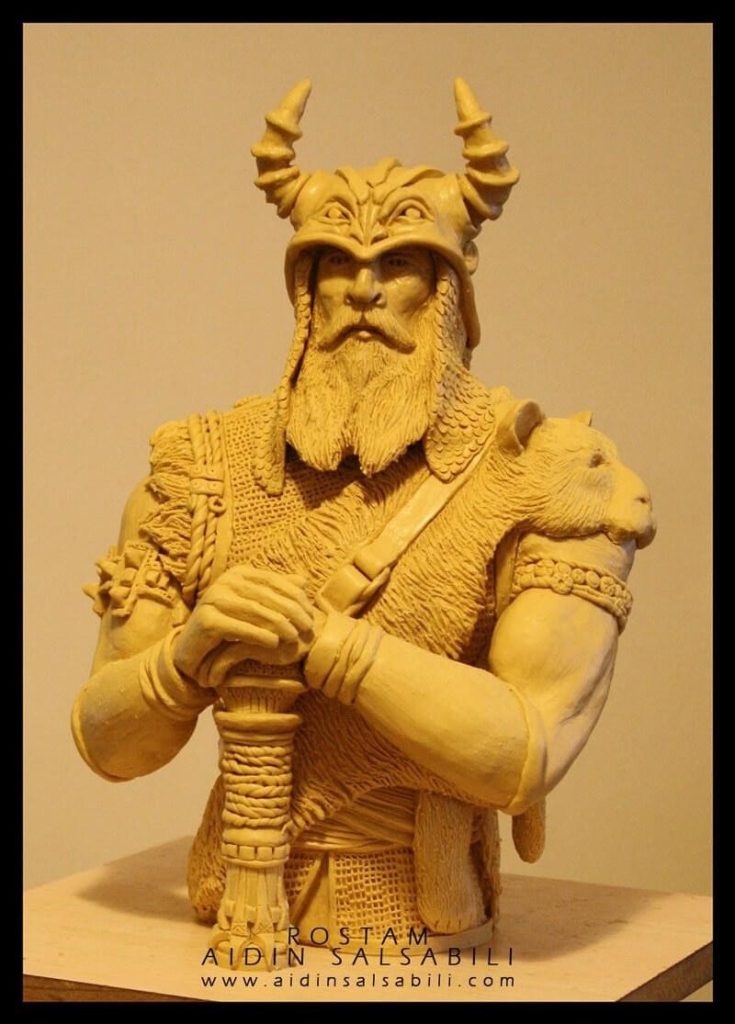
Rostam is one of the greatest warriors in Iranian mythology. Most of the stories in the Shahnameh are about his valor and courage.
He symbolizes physical and spiritual strength and sacrifice for his country, Iran. He was so strong that he could knock down an elephant with his mace. In addition to being powerful, Rostam is also a symbol of ethics, bravery, knowledge, and wisdom.
Rakhsh
Rakhsh is Rostam’s robust and attentive horse. Rostam chose him because he was the only horse that could bear the weight of Rostam’s hand on his back and did not bend his back during this test. He is a road horse for Rostam and his assistant and aid. For example, Rakhsh wakes up Rostam and informs him of the dragon’s danger in the third Khan by knocking his hoof on the ground. Rakhsh goes through hardships and battles with Rostam step by step and finally dies with him.
Sohrab
He is Rostam’s son who grows up away from his father and turns into a brave and strong young man without knowing his father or Rostam being aware of his existence. Father and son unwillingly go to war in the tragedy of Rostam and Sohrab.
The battle between Rostam and Sohrab is one of the saddest Iranian folklore stories. It involves the death of the son at the hands of the father and the healing potion that arrives too late after Sohrab’s death.
Siyâvash or Siavash
In Iranian myths, Siavash is a handsome prince who learns all the practices and skills of princehood from Rostam. He is the son of Kaykavus, the king of Iran. Since Siavash refuses to give in to the temptations of his father’s wife, Sudabah, his father asks him to prove his innocence by walking through fire. Siavash passes through the fire safely, But in the end, he becomes a victim of GGarsivaz’s conspiracies.
“Mourning Siavash” or “Siavashoon” is a type of fertility ritual that was held in grief of Siavash’s death. Traces of this ritual still exist in Iran.
Iranian Myths, a Reflection of Persian Folklore and Beliefs
Persian myths are the root of our culture and beliefs passed down through generations, ciphered into fiction, and sometimes mixed with imagination. Real events in people’s lives are the main source of legends and myths. As Ferdowsi also says:
“Do not assume this is a lie and legend
Do not consider it an enchanting story
If some aspects appear illogical and contradict common sense
it has a hidden meaning.”
Iranian myths are so powerful and intelligent that they have traveled to faraway lands and been embraced by the hearts and cultures of other nations. Even today, their effects can be found in other countries and cultures.
Persian folklore is one of several important roots of Persian culture and identity. Throughout history, whenever foreign invaders and malicious forces scorched the proverbial tree, the Iranian nation has risen from the ashes stronger, reinforced by these roots. Iranian mythology is an ancient and mysterious root of the Iranian nation’s tree, representing our land’s rich civilization and valuable history.
New generations may not be interested in history and find historians boring, But the language of stories and legends will always captivate them. They receive moral and emotional lessons from myths and legends, they learn patriotism from Rostam, and wisdom from Zal.
Simply put, the secret to the survival of the Persian language, culture, social concepts, and rich traditions is the direct or indirect preservation of these Iranian legends and folklore.
Frequently Asked Questions About Iranian Myths
If you cannot find the answer to your questions in the following, share your questions with us through the comments section of this post. We will answer them as soon as possible.
What are the most important first- sources for understanding Iranian myths?
Shahnameh and The Zoroastrian Holy Book, Avesta. These three sources describe many characters and stories in Persian folklore.
Is Izad Mithra female or male?
Mithra is a male god and the son of Ahura Mazda. He is one of the Persian deities associated with the sun and light. Before the rise of Christianity, he was worshiped in Europe in a cult-like religion known as Mithraism.
What are some famous Iranian mythological figures in the Shahnameh?
Good Shahnameh characters include Jamshid, Fereydun, Rostam, Siavash, Kaveh, and Arash Kamangir.
Evil or Ahriman Persian mythology characters include Angra Mainyu, Zahhak, Div-e Sepid, and Garsivaz.
What are the most famous Iranian myths?
Some of Iran’s famous mythological stories include the epic of Rostam, the uprising of Kaveh the Blacksmith, Bijan and Manijeh’s love story, and the sacrifice of Arash the Archer in setting the borders of Iran and Turan.
Which books contain the names and stories of ancient Iranian myths?
The books “Avesta” and “Shahnameh” are the main sources for learning the names of ancient Iranian myths and their stories.
What are some of the most famous Iranian legends and Persian folklore stories?
Anahita, Bahram, and Mithra are among the Persian gods. Simurgh and Rakhsh are famous mythical creatures. Div-e Sepid, Akvan the Div, the Devil, and Garsivaz are evil forces in myths. Jamshid, Rostam, Kaveh, and Arash are legendary Shahnameh characters in Iranian legends.


